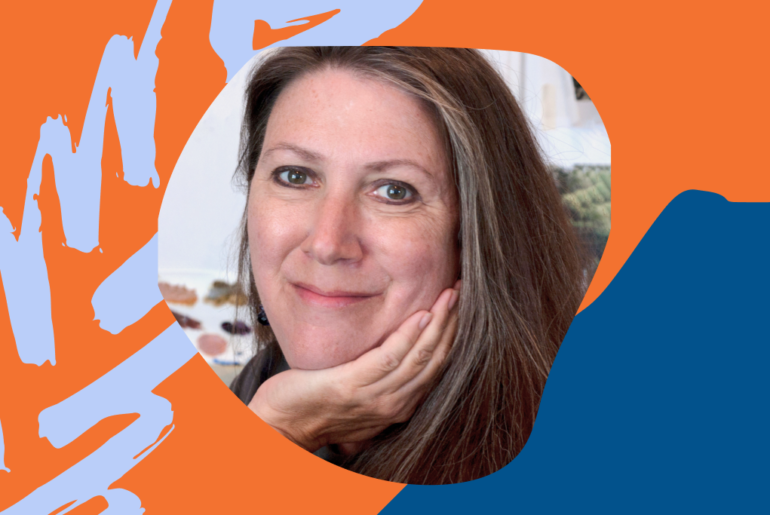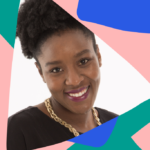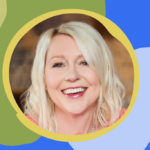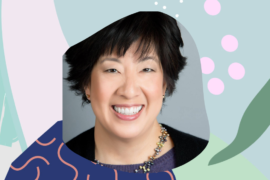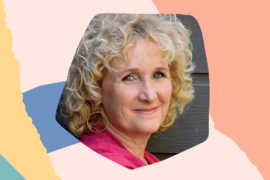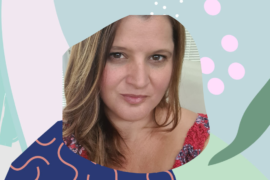When she finished graduate school, Mary Gilkerson had a portfolio and an MFA — but not the experience, skills, or tools to support herself as a working artist. She spent the next 20 years teaching painting to women all over the world, but also found herself at a crossroads: she could either stay in academia or become more active as her art career picked up momentum.
She then started teaching painting online, but found herself challenged by launching multiple times per year. Now, at MaryGilkerson.com she takes a more holistic approach to teaching aspiring and working artists, including the skills you need to grow and run your artistic business.
Today, Mary joins the podcast to share her journey from aspiring fine artist in New York to where she is today, how her great grandfather taught her about entrepreneurship, and how the membership model allows her to offer more than just painting classes while giving her the freedom she needs to create.
Key Takeaways
- The challenges aspiring artists face as they enter the working world for the first time — and why so many of them feel limited by their job options.
- How Mary’s great grandfather’s diary helped her become the entrepreneur she is today.
- The often perpetuated myths about being a working artist and making money — and why they should never hold you back.
- How moving to a membership model helped Mary take away the stress brought on by launching multiple online courses several times a year.
- Why artists have to create — and how to find the entrepreneurial model that will allow you to pursue your creative work without starving.
Free Give
 FREE Guide – Launch & Grow a Profitable Membership Site
FREE Guide – Launch & Grow a Profitable Membership Site
Ready to reclaim your time and attract more monthly paying customers? Our step-by-step guide will show you how to build a membership site that turns your passion into recurring profit. Click here to download!
Memorable Quote
This is not an impossible dream. This is something that people do. They’ve been doing it. It’s something that is achievable for anyone. You have to define what success is for you and then go out and do it.” – Mary Gilkerson
Episode Resources
Transcript
Read The TranscriptShelli: Mary Gilkerson, welcome to the It’s a TRIBE Thing Podcast. How are you?
Mary: I’m doing great. How are you doing, Shelli?
Shelli: I am amazing and I’m super stoked to share both you and your story with our amazing listeners and with that said, I’m hoping you can let us know how your entrepreneurial journey unfolded, how you ended up where you are right now, and also and more importantly, where you started before you started taking your first steps.
Mary: Okay. I’d love to dive into that. I started out with a fairly traditional art background. I majored in art in college and like everybody else who’s a young artist, decided I had to head to New York after that and starved and froze for a while because there are 40 million other artists walking down the street. I had a little bit of a challenge when I was walking down Park Avenue with my portfolio and half of the other people on the street were doing the exact same thing. I thought, “There may be a problem here.” After staying in New York for a while, I came back to South Carolina and went to graduate school and when I finished my MFA there were really limited options available. They didn’t do very much to teach us how to make a living as an artist. So, the choices that you had were you could go into graphic design, which I’ve already done or you could go into college teaching, or you can go and starve. And I chose not to starve, that not being a real fun thing to do. So, I got a job luckily right off the bat teaching at a small women’s college which was wonderful. So, I taught painting for over 20 years to fantastic women all over the world.
But at the same time, I always had a side gig. I always wanted to be my own boss and it got to the point where I was selling my work, three galleries, becoming more active exhibition-wise, and I realized it was really time to leave academia behind. It was either take the leap now or never take the leap. And by staying and not taking the leap, I wasn’t providing a really good example for my students so that they would see they had options out there.
Shelli: That totally makes sense, yeah.
Mary: Yeah. So, I started teaching online and took what I was teaching at the college level and just translated it over really fast. I mean, I’m one of those quick starts so done is better than perfect and rammed it over there and really got it up fast and started teaching painting online. Loved doing it. And that bumped along for a while. I was able to quit teaching but I was stuck on that treadmill of launching of the every-quarterly launch where you have that kind of up-and-down cash flow that can be more than a little bit anxiety producing.
Shelli: So, you’re teaching courses at the time, like art courses. Is that right?
Mary: Yeah. I was teaching two painting courses and an art business course online.
Shelli: Got it. Okay. I was just going to ask you. So, I’m interested in knowing so what that leap of faith felt like when you took it and also, whether you had any experience running a business or teaching courses online and how you kind of made that bridge, that gap that made that transformation.
Mary: Yeah. I had taught courses online before because at the college we were an early adopter of online teaching and I was one of the early ones. I’m a tech geek. I taught graphic design in Photoshop and online. I can take a Mac apart. I love the technology side of it too. So, I was really comfortable with teaching online. I had run my own side business, and it was beginning to make money so I knew how to run a business to a point, not how to run it without any other secondary income then but my parents are not entrepreneurs but my grandparents were. So, about that same time I inherited my grandfather’s diary and so I couldn’t go to talk to my parents about being an entrepreneur but I really dove into his letters.
Shelli: Oh, that’s amazing!
Mary: One of the things that really stuck with me, actually, it was my great-grandfather, one of the things that stuck with me was a phrase he used about something he was looking at doing and he talked about, “This is full of opportunity.” That’s the key. He didn’t see the glass ever being half-empty. He always saw it half full and the whole range of opportunities out there so that was what separated him from other people who are not as successful. So, he didn’t have the Internet but he still managed to dive into a variety of different areas to be successful. So, I just kept going back and reading his letters and kind of trying to channel him as my mentor. So, it was still a little bit rocky in there. I didn’t make the final leap to quit the college until I had saved up the equivalent of at least I think I had eight months’ salary saved, almost a year’s salary. So, that I had a cushion and I knew I could experiment with that. So, I’ve been running the business online for about six months at that point and I just banked everything that I made online. So, I’m pretty comfortable with risk-taking as long as I would assess the risk first if that makes sense.
Shelli: Yeah. Absolutely. And so, at the time, when you said you’re banking everything you’re making, so you’ve launched how many courses at this time during that period of time?
Mary: I had two courses up and running at that time and had launched four times.
Shelli: Wow. That’s a lot.
Mary: Yeah. I was doing it every three months, launch, launch, launch, and I had a fairly small list when I started out but launching like that and I was launching with webinars, I built up a list pretty quickly. Because they were small, they were hyperactive, hyper-responsive. They were really interested in what I was doing. It was also the early days of anybody teaching painting online. There really wasn’t any competition out there so I had a big cushion.
Shelli: So, as an entrepreneur, what did your life feel like, your personal life, as you’re launching so often with these courses that are getting a great response but what did it take you personally to be able to do it? Like, what it cost you personally in terms of what that looks like for your life?
Mary: Hustle, a lot of hustling, not a whole lot of personal life because I was doing that at the same time, I had a full-time job. Now, it was flexible as academia is but still and I was doing some administrative work at the college too so I was working a good I would say 18-hour days between a few jobs. It was crazy making. So, I was ready to find a way to make life a little bit more manageable, definitely for sure. So, I had built up at the same time a free Facebook group that I was putting material into content into nurturing and growing and it was getting larger. It was at about 5,000 people in the fall of 2016 to the spring of 2017 and I can’t really figure out how to capitalize on that yet, but I had it at the back of my mind that I was going to – I certainly pulled from that group to launch my courses but I hadn’t figured out how I wanted to start a membership. And I’ve heard about memberships. I belong to a couple of memberships but I just hadn’t quite figured out what the framework was going to be that would work for me with my model. I knew I didn’t just want to do here’s how you paint trees, here’s how you paint rocks. I wanted to do a more holistic approach because you can burn out on painting rocks really fast.
Shelli: I can imagine. Yeah.
Mary: So, I was looking at something that was not what I got when I was in college and what we were only beginning to be able to offer to our students at the college level, something that talked about an artist’s life in a more holistic way.
Shelli: Oh, I love that.
Mary: The skills that you need to grow, the business, running it as a business, and seeing making money as a good thing and not selling out because there’s this huge big myth in the art world that if you make money off of your art, you’re selling out. And so, your only alternative is to be a starving artist, Bohemian living in a garret drinking all day long. And those two options just were not good ones.
Shelli: That’s an amazing reframe because I love that you saw the need and what was missing for the artist to be successful, yet still stay in their genius and in their lane and live the life that is true to them, but also do it in a way that allows them to have a quality of life.
Mary: Yeah. The myth was just so pervasive and so toxic. It’s still pervasive out there. I run into that, “You can’t sell your art. If you sell your art, you’re selling out.” It drives me absolutely crazy. But it’s just because the artist hasn’t gotten the tools or haven’t been given the tools to see that that’s just a limiting belief. So, I started playing around in the free Facebook group dealing with all three of those things and looking at it more holistically. And then last spring it all kind of finally came together and it took me for what seemed like forever to figure out what I wanted to do with the membership. I launched it in May and offered a special deal for students that had already come through my courses because I wanted to have a cohort, a good body of people in there so that it wouldn’t be an empty lot. There’s nothing worse than a community that’s an empty lot and I surveyed the members of my free Facebook group and asked them what they wanted. I still was thinking that what they really wanted was painting tutorials, how to do specific painting skills-oriented issues but, boy, was I shocked when I got the survey results back and had a really good response rate from the group. I got almost a thousand responses.
Shelli: Wow. One in five. That’s incredible.
Mary: Yeah. Well, at that point the group was about 7,000 or 8000 so it’s grown a lot. It’s almost 10,000 now. So, I had really good data to work with and overwhelmingly, they wanted community and they wanted community in a safe environment, a place that felt like it wasn’t full of distractions where they could share personally and share their work and get feedback in an honest way that was supportive but also deep and meaningful. So, I kind of shifted my perspective about, well, actually this kind of validates my more holistic approach and we opened up at the end of May and launched it directly into that free Facebook group and offered them a founders deal, and more than 100 of them signed up.
Shelli: That’s fantastic.
Mary: I was overwhelmed with their response. It really was fantastic so we’ve been getting along for six months now and are going to be opening up the registry or opening up the membership again in January.
Shelli: That’s fantastic. So, what has been the feedback? Because it sounds like in a way like there are like mindset memberships or mindset places that you can go to brush up on your limiting beliefs and reframe stuff, and then as an artist, there’s a place you can go for painting or tutorials or the tools. What has been the favorite and most rewarding feedback from your people once you’ve combined this and offer them the thing that they were looking for they maybe didn’t even know they needed?
Mary: I think the thing that has gotten, there are two different themes or focuses that we’ve had that really got a lot of response. One was back in the summer we did a cloud challenge so we did a daily painting challenge periodically and they love that. So, it was dealing with all of the above but mainly mindset and skill developed naturally because if you’re painting every day, you’re going to improve. So, it was getting over the belief that you can’t paint fast and that you can’t paint from observation and connecting with the history of all the other artists who loved painting outside and painting the sky, and love of nature. I think we all had a blast on that and it fed my own painting practice in a way that I did not anticipate at all. So, I had a blast doing it too. Then this past November and the first half of December, we did a holiday promotion challenge. So, a lot of them had not ever really consistently marketed their work before or thought about how they could launch paintings. So, we did six weeks of training around how to create a holiday promotion and then around that Black Friday weekend, some of them a little earlier, some of them a little later, they created launches that went off out to the world.
A couple of them did in-person launches and did open studios, have one that sold 14 paintings in her open studio and ran a contest to get the foot traffic because her studio was her home. She was worried that she wouldn’t have enough people show up, so she promoted it with anybody who came would have the opportunity to win a painting and she had excellent traffic as a result. She used Instagram and Facebook to do that promotion. So, it showed them that it’s possible to do something in-person and still use social media to get that word out. She has been on fire since she sold 14 paintings. She’s never sold that many before at one time.
Shelli: No doubt. Do you find in your community that you are finding a shift in the realization that you can be an artist and be in your truth as an artist, but also incorporate some entrepreneurialism and actually make a living from the thing that you love?
Mary: Yeah. I think it’s beginning to dawn that this is not an impossible dream that this is something that not only do people do it. They’ve been doing it. They just hadn’t heard the stories before and it’s something that is achievable for each of them. They have to define what success is for them and then go out and do it.
Shelli: I love that. It’s so interesting that from that sacred diary you got from your great-grandfather and the quote, “This is full of opportunity,” that entrepreneurialism is in your DNA and as an artist, you’re able to share that gift with artists who maybe didn’t have that gift and that blessing and that incredible diary and that family history of being an innovator and being able to create on ideas. And I’m wondering for the artists that you serve, what do you think is the cost of an artist when they don’t live their truth, when they say aren’t a part of your community and they don’t realize that they can actually make a living from what they’re doing? What do you think is the cost to those people personally?
Mary: It’s huge and it’s not just to them. It’s to their families and to their communities. I’m thinking back to when my daughter was in middle school and I had taken on a lot of administration work at the college. I wasn’t getting into the studio as often and I got really, really cranky. I’m not pleasant when I don’t get to paint and she turned around and looked at me and said, “Mom, you just need to go paint. Get to the studio.”
Shelli: Out of the mouth…
Mary: Wise words. Totally. Totally. I think it costs them internally through their health because anytime you hold stuff in, you’re going to get sick more. When you don’t get to express your creativity and it doesn’t get to come out in some way, it’s going to stifle and it’s going to fester. So, it’s not a matter of making a whole lot of money at it. It’s about making impact. So, everybody can get out there and make an impact and I think once they realize that, the money follows.
Shelli: Yeah. That’s a really, really great insight too. When you have the knowledge and the skills and the permission to follow your passion, the money always follows you.
Mary: It does. It really, really does. There’s another student that I have that took the daily painting challenge and extended it out over three months and mimicked the project I had done four or five years ago that I told them about. And I’d given them the framework to go do it and so she did a painting a day for 90 days, posted it on social media for 90 days and you could track her progress. Her paintings made a dramatic improvement. And out of that, which is that getting it out there, the money followed because she got offers for exhibitions and sold paintings. And it wasn’t because she was chasing galleries or chasing down exhibition spaces. It was because she was just showing up in an authentic and true real way and she’s developed an audience which is what it’s all about is creating that flow between your studio, your artwork, and your audience.
Shelli: Brilliant. Well, if people are looking for you online or if there are artists out there that are looking for the kind of support you offer, where is the best place to find you online?
Mary: Best place to find me is my website at MaryGilkerson.com. I’m on Facebook and Instagram at Mary Gilkerson Art and tell them just to hit me up there and send me a DM and I’ll be happy to talk with them about where they are.
Shelli: Amazing. You’re awesome and we appreciate your time and you hanging out with us on the It’s a TRIBE Thing Podcast.
Mary: Thank you so much. Happy painting, everybody.
[END]
